Sukhoi Su-27M (Su-35) "Super Flanker"
Role: multi-role air superiority fighter
Builder: Sukhoi, KnAAPO
Variants: Su-27M (Su-35), Su-35UB
Operators: Russia
Introduction
The Su-27M (factory designation T-10M) was conceived as a new upgraded variant of the Su-27 'Flanker' incorporating a true air-to-surface capability. Although the capability to carry air-to-surface weapons had been added to the baseline Su-27S, it was limited to 'dumb' bombs and unguided rockets. The Su-27's fire control system lacked a dedicated ground target acquisition and identification capability. The air-to-air capability would also be improved to restore the balance with the contemporary F-15C and F-16C. Although Su-27M remained the Russian military designation, the Su-27M later received the Su-35 designation to enter the global fighter market. Having failed to attract any orders for the Su-35 between 1992 and 2002, Sukhoi started a new development program for the modernization of the single-seat Su-27 in 2002 under the bureau/factory designation of T-10BM (Bolshaya Modernizatsiya - Big Modernization). This latest Flanker derivative also aimed at the export market retained the Su-35 designation of its predecessor, despite significant differences between the two Flanker derivatives. See Su-35 "4++ Generation Flanker" for more information, this section further details the original Su-35, the Su-27M.
N011 Radar
The Su-27M was equipped with the upgraded RLSU-27 radar system. The system was composed of
the new forward-looking N011 radar with slotted-array and the smaller N012 rear-looking
radar, the latter is located in the central tailboom. Compared to the
RLPK-27 system with the N001 radar of the basic Su-27 variants,
the RLSU-27 system offered extended target acquisition range, air-to-surface stand-off attack capability,
simultaneous tracking of more targets, surveillance and tracking of targets in the rear hemisphere and
improved counter ECM. The new radar system also provided terrain-mapping, enabling
nap-of-the-eartch (NOE) flying and obstacle avoidance.
Later it was concluded that the slotted-array would be outdated soon,
and a phased array variant of the N011 radar, designated N011M, was fitted to the Su-27M.
The phased array enabled a greater radar range, wider zones of tracking and engagement,
increase in number of simultaneously tracked and engaged targets, and the employment
of more advanced weapons.
Advanced Avionics
In addition to the radar, the Su-27M featured other advancements in its avionics suite compared to the Su-27. New components were the electro-optical sighting/navigation system, communications suite, instrument guidance equipment, new FBW system, IFF and digital computer. The aircraft was equipped with an advanced self-defence suite consisting of new RWR systems, Sorbtsiya ECM pods, and APP-50 chaff/flare dispenser.
Modernized Cockpit
The instrument panel layout was changed to accomodate three high-res multifuction monochrome CRT displays and an improved HUD, reducing the number of electro-mechanical instruments. The Su-35 was also offered with multifunction colour LCD displays. The IRST sensor was moved to the right off the line of symmetry to improve visibility from the cockpit. The ejection seat was elevated and declined at 30 degrees to enable the pilot to better withstand high G manoeuvering. The pilot would wear a helmet with the Shchel-3UM helmet-mounted target designator.
Improved Airframe
The Su-27M airframe incorporated a new nose section, new central tailboom, canards, and
uprated AL-31FM engines. The wings panels were fitted with larger fuel cells and the enlarged
fins have internal fuel cells as well increasing the aircraft's combat radius. Furthermore the Su-27M
was fitted with a retractable in-flight refueling probe and the provision to carry two 2,000-litre
underwing drop tanks to further extend its range.
The aircraft's structure and undercarriage was strengthened to cope
with the increased weight of the aircraft caused by the new equipment.
The single nose wheel was replaced by two smaller wheels.
Modern Weapons
The new systems enabled the Su-27M to be capable of using modern air launched weapons.
The most important addition for the air-to-air role was the medium-range active radar homing R-77
(export designation is RVV-AE) air-to-air missile, the
Russian equivalent of the AIM-120 AMRAAM. Up to twelve of these missiles could be carried or ten
when equipped with wingtip ECM pods. The Su-27M retained the capability to be armed with the
older R-27 semi-active radar, R-27E IR homing medium-range missiles as well as the short-range R-60
and R-73 IR homing missiles. All of which have since been developed into more effective versions.
The Su-27M armament suite also included guided air-to-surface missiles and bombs. Aside from the unguided
rockets already on the basic Su-27's weapons list, the Su-27M was now also capable of the Kh-29 TV-guided,
Kh-31P anti-radiation, and Kh-31A anti-ship missiles. In addition to the increased number of "dumb" free-fall, retarded,
incendiary, and cluster bombs, the TV-guided and laser-guided KAB-500 bombs were planned to be integrated.
Su-35 Multi-Role Fighter
These new systems and weapons capabilities made the Flanker a true multi-role fighter. Following the collapse of the Soviet Union, the Su-27M development slowed down and prospects of any significant production for the Russian air force soon vanished. Owing to its true multi-role capability, large action radius and reasonable price tag, the Su-27M was considered a good candidate for export. The Su-27M designated Su-35 was first shown at Farnborough international air show in 1993. Early attempts included the Su-35 based Su-37MR, which was marketed to the United Arab Emirates (UAE), see Su-37 section. After the initial series production of three Su-27Ms had been completed for state trials, the Komsomolsk-on-Amur aircraft manufacturing association (KnAAPO) suspended production and refocused on meeting the requirements of possible export customers. Among the customization options was the possibility to equip the Su-35 with AL-31FP TVC engines, which were developed following the successful Su-37 trials with the first generation of AL-31FU TVC engines, see Su-37 section. Other improvements for the export Su-35 also included an open architecture avionics suite incorporating the latest digital computers and display systems.
Su-35UB Two-Seater
Another step towards meeting future customer requirements was to develop a twin-seat combat trainer variant of the Su-35. Sukhoi and KnAAPO developed the Su-35UB. The first Su-35UB prototype (bort number 801) built by KnAAPO made its first flight on August 7, 2000. It was first shown at the MAKS 2003 air show and subsequently served as a technology demonstrator and test aircraft for various avionics, including the Zhuk-MSE radar.
Fierce Market Competition
Despite efforts by Sukhoi and KnAAPO to market the Su-35, it did not receive any orders.
The Su-35 had been considered by a number of nations for their next generation fighter
program. These include South Korea, Singapore, Australia and Brazil. Apart from Brazil,
the Su-35 failed to get shortlisted by these countries, which preferred variants based on the
F-15E by Boeing, the Lockheed F-35 Joint Strike Fighter
, Eurofighter Typhoon or Dassault Rafale
instead.
Brazil however was forced to postpone the decision, but had shortlisted
the Su-35 together with the Mirage 2000BR and the Saab Gripen initially. Sukhoi/KnAAPO
introduced the designation Su-35BR for the customized Su-35s that could be developed for Brazil.
Before completition of the second round the Brazilian F-X program was cancelled.
Another South American candidate for the Su-35 emerged in the form of Venezuela soon after. The country
was effectively forced to consider Russian fighters to replace its F-16 fleet, following the US arms embargo that was imposed on it
in May 2006. The Su-35 was one of the options considered, however the multi-role Su-30MK variant had matured over the
years incorporating some of the improvements of the Su-27M. More importantly, the Su-30MKK and Su-30MKK2
had entered full production at KnAAPO for China. The FAV quickly opted for the Su-30MK2.
See Su-30MK2 for more information
Status of the Su-27M program
In total 17 Su-27M aircraft were built by Sukhoi and KnAAPO; five prototypes converted from Su-27s, two static test airframes, six pre-production test aircraft, three production aircraft, and one Su-35UB prototype. Although the Su-35 (Su-27M) had no success on the global fighter market, the Su-27M line greatly contributed to the development of the Flanker family, both in terms of aerodynamics and avionics. The Su-27M saw the introduction of canards and 3D fly-by-wire control for enhanced manoeuvrability. The final two preproduction aircraft T10M-11 and T10M-12 (bort numbers 711 and 712) tested the N011M phased-array radar. Aircraft '711' went on to become the Su-37 and was soon after converted to thrust vector control (TVC) demonstrator, fitted with AL-31FU and modified FBW system. See Su-37 section.
All of the aforementioned innovations were subsequently further developed to be fitted to Irkut's Su-30MKI for India, and subsequently the Malaysian Su-30MKM and Algerian Su-30MKA. KnAAPO's Su-30MKK and Su-30MK2 versions inherited the enlarged tailfins providing additional fuel capacity of the Su-27M. See Su-30MK section.
Although the Russian Air Force never ordered more Su-27Ms to enter production for operational service, the handful of early Su-27M types continue to serve the air force. Five of the preproduction and production aircraft have been assigned to the Russian Knights display team, since the state trials of the type were suspended in the mid 1990s.
Su-27M '710' (T10M-10) continued to serve the company as a flying testbed in 2004-2006, flight testing the advanced AL-31F derivative by NPO Saturn, dubbed 117S (AL-41F), the new turbofan will power the next Su-27 derivative, which will also carry the Su-35 designation.
The Next Su-35
Sukhoi realized by 2002 that the original Su-35 (Su-27M) would no longer be able to compete with comtemporary and future foreign fighters. Furthermore, the Sukhoi-owned KnAAPO plant had been struggling to compete with its Su-30MK2 against the more advanced Su-30MKI derivatives of the Irkut Corporation, its rival Flanker producer only partially owned by Sukhoi. Sukhoi started development of a new 'intermediate fighter' to fill the gap between its "fourth generation" Su-30MK and the upcoming "fifth generation" fighter in development under the PAK-FA (Perspektivnyi Aviatsionnyi Kompleks Frontovoi Aviatsii - Future Air System for Tactical Aviation) program, while offering a KnAAPO alternative to Irkut's Su-30MKI line. Contrary to earlier reports, the resulting "4++ generation fighter" has materialized as a new Su-27 derivative as opposed to upgrade of the Su-27M. Re-using the Su-35 sans suffix designation, the Su-27 Bolshaya Modernizatsiya ('big modernization', factory designation T-10BM) differs significantly from the Su-27M, having been redesigned from the basic Su-27 configuration incorporating the improvements developed for the Su-27SM2 upgrade program. For more information regarding the new Su-35 see the next section...
-
Sources:
- Butowski, Piotr (2008). Sukhoi's Latest 'Flanker', Combat Aircraft, European Edition, Vol.9, No.3, pp. 52-55, Ian Allan Publishing Ltd, UK.
- Fomin, Andrei (2000). Su-27 Flanker Story, RA Intervestnik, Moscow, Russia.
- Fomin, Andrei (2007). Su-35 - a step away from the fifth generation, Take-off, June 2007, pp. 46-53, Aeromedia Ltd, Moscow. Retrieved from www.sukhoi.org, last accessed on March 27, 2008.
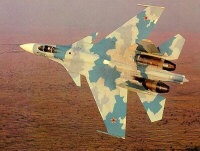
Su-35 Super Flanker
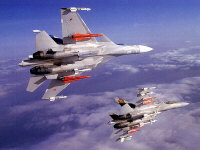
Su-35s showing their weapons capability
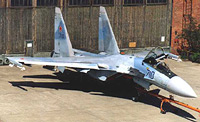
Production T10-M10 received N011M radar
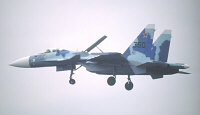
Redesigned nose section and enlarged fins
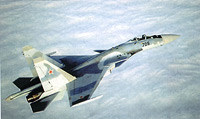
Series produced Su-35 in initial camouflage
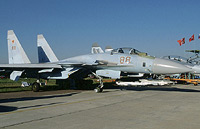
Production Su-35 '88' delivered
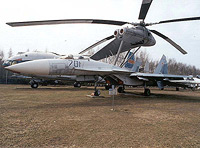
Prototype T10M-1 '701' on display at Monino
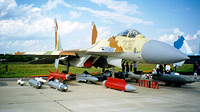
Su-35 displaying its multi-role capability
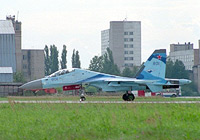
Su-35UB '801' two-seater
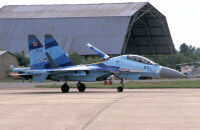
Su-35UB seen at MAKS 2003
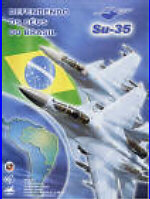
Su-35 promotion for Brazil

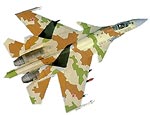


 Back to Index
Back to Index